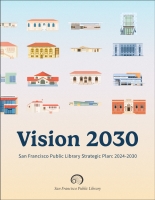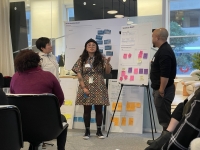Strategic Planning Implementation
San Francisco Public Library
Innovation Synopsis
San Francisco Public Library (SFPL) recently undertook a comprehensive strategic planning effort rooted in community and staff feedback to reflect and adapt to the evolving role of public libraries. The new Plan, “Vision 2030,” incorporates feedback from nine branch tours, 2,283 user survey responses, 19 community focus groups, 604 non-library user survey responses, 460 staff survey responses and 71 internal meetings and workshops. A team of 32 staff ambassadors from all levels of the organization participated in development of the plan from start to finish, providing valuable insights and building internal support among staff. Vision 2030’s foundation in patron and staff insights resulted in a modern vision and articulable roadmap for San Francisco Public Library that is reflective of patron needs and re-envisions how 21st century libraries can best serve their communities.
Challenge/Opportunity
The COVID-19 pandemic accelerated existing trends in how patrons engage differently with their libraries. As both physical circulation and visits have failed to recover to pre-2020 levels, SFPL users’ behavior has continued to shift towards increased adoption of digital collections and resources. Simultaneously, economic and social changes such as leaner corporate structures and remote work environments have created an opportunity for libraries to be on the forefront of providing education, skills, opportunities, and cultural experiences for communities beyond the traditional circulation of physical materials. As reliance on physical materials wanes, the industry must confront the question of how to stay useful to changing patron needs. SF Public Library’s Vision 2030 creates a roadmap for rethinking our role in a rapidly transforming environment.
Key Elements of Innovation
SFPL has taken an innovative approach to implementing this Plan. To make the high-level vision and goals actionable, our leadership team parsed each of more than 80 discrete outcomes named in the Plan into their component parts. We asked of each: “what specific actions, taken together, do we need to take to achieve this outcome.” This resulted in nearly 600 specific and actionable actions, metrics, and objectives, all of which ties directly back to the Plan’s strategic vision. This level of specificity allows us to build specific actions and tasks into staff workplans and know that the work directly supports the strategic vision and goals. Additionally, the extent to which we prioritized stakeholder feedback pushes the boundaries of traditional strategic plans. This focus ensured that our vision and goals align with what the community wants the organization to do and represent, keeping us forward-looking and focused on service.
Achieved Outcomes
Vision 2030 was adopted by the San Francisco Public Library in March 2024, a major outcome for a new and ambitious plan. To ensure that the plan was tangible and actionable, we spent the next two months identifying nearly 600 specific actions, tasks, and metrics which taken together achieve the higher-level outcomes identified in the plan. As SFPL transitions from planning to implementation in FY25, we have already incorporated the first of these actions into library divisions’ annual work plans, a major milestone. Investing this level of attention to developing actionable steps that can be easily woven into work plans lays the table for projects and initiatives to launch over the next several years. Importantly, the specificity also enables SFPL to monitor its progress towards achieving our goals, and the work’s impact on our community.



